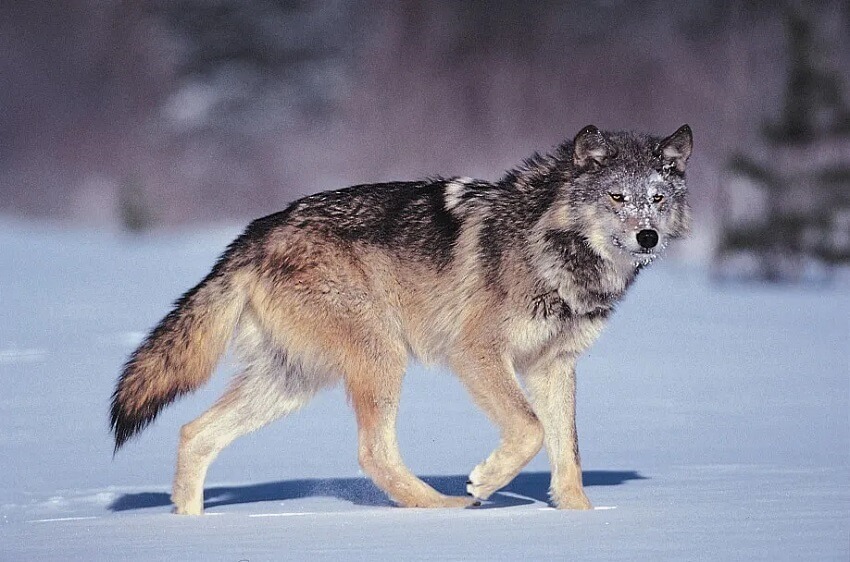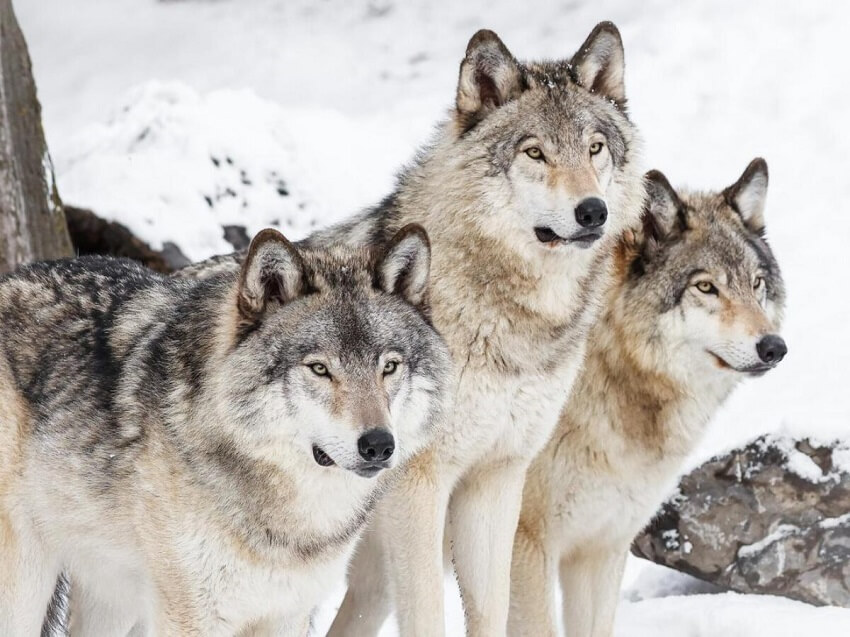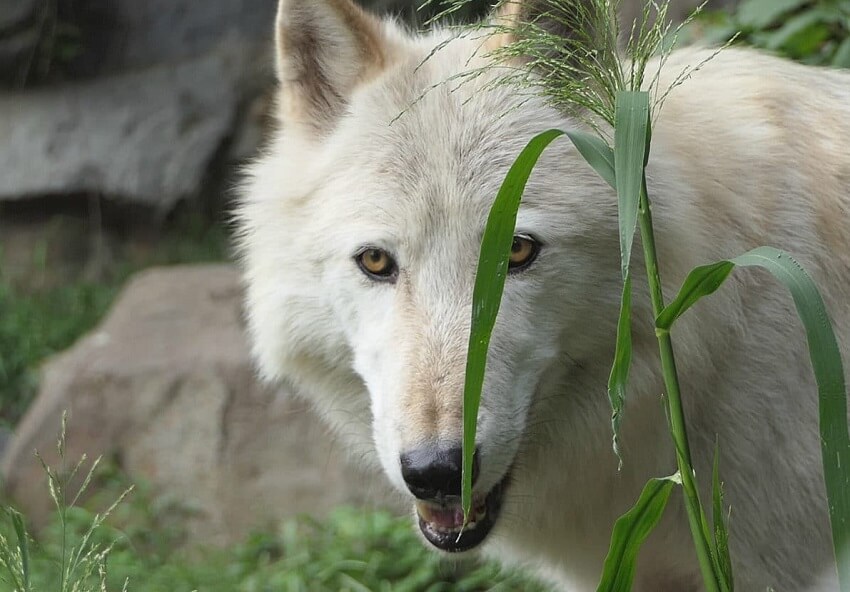Wolfs are symbols of beauty and strength, representing both good and evil. In some North European myths, a wolf was the deity that nursed Romulus and Remus, the founders of Rome. The wolf was also the first animal domesticated by humans. Yet, wolves still hold many fascinating secrets that humans have yet to discover. Join KnowAllAnimals to explore some Little Known Facts About Wolves in this article!
1. Little Known Facts About Wolves You Probably Didn’t Know
Wolves are not just symbols of power and wilderness; they also hold many interesting, little-known secrets. Let’s uncover some unique truths about these mysterious animals.
1.1. Black Wolves
The common coat colors for wolves are white and gray, but a small number have a very special black coat. The truth is, this isn’t a natural color for them. A 2008 study from Stanford University showed that a specific gene for black fur is only present in dogs, meaning black wolves are likely the result of crossbreeding. This black-fur gene is dominant, so it is passed down to most of their offspring. Although black wolves are not necessarily superior hunters, they do have a better immune system. Black wolves are found almost exclusively in the cold regions of North America.

1.2. The Ratio of Hybrid Wolves
Purebred wolves are becoming quite rare. Instead, hybrid wolf populations are thriving due to environmental conditions. Over the years, as human populations have moved east, they have encroached on the wolves’ natural habitats, leading to an increase in hybrid wolf breeds that now make up a large portion of the population. Hybrid wolves are often smaller than purebred wolves and are extremely intelligent, able to adapt to urban and suburban areas. In part, this is due to hunting in natural habitats, which has significantly reduced the number of purebred wolves.
1.3. Cannibalism
Cannibalism is quite common in the wolf world. They live in extremely harsh environments, often in cold regions with scarce food sources, and must compete with many other predators. This forces them to eat injured or sick wolves within their pack. When two wolf packs fight over territory, a fierce confrontation often occurs, and the losers become prey for the winners. The truth is, they are sometimes even forced to eat their own offspring.
1.4. Weight
We often think of wolves as being nimble and agile, but some species can weigh up to nearly 100 kg. Wolves in tropical regions are often small, comparable to a medium-sized dog. But as you go farther north (Alaska, Canada, and Russia), their size increases. The largest wolf ever killed in North America (Alaska) in 1939 weighed nearly 90 kg. These are usually alpha wolves, as they are always well-fed by the rest of the pack.

1.5. Rabies and “Going Mad”
Unlike many other animals that become lethargic, disoriented, and often lie still when infected with rabies, wolves become incredibly dangerous. They seem to immediately go into a frenzy and can attack any animal around them, even those larger than themselves. Most cases of wolves attacking humans are due to rabies, although this is less common now. While there are treatments for humans bitten by rabid animals, wolves tend to attack the neck and head of their victims, making most cases extremely dangerous. In normal circumstances, wolves usually tend to avoid animals larger than themselves.
1.6. American Wolves Are Quite Gentle
In fact, wolves in North America are quite gentle and attack humans less frequently than those elsewhere. There are very few recorded incidents of wolf attacks on humans in the U.S. and Canada, whereas the opposite is true for Europe and Asia. According to historical records, more than 3,000 people were killed by wolf attacks in France between the 1600s and 1800s. Wolves in India and Russia are most famous for their ferocity and aggression. During World War I, Allied forces struggled to defend against attacks from hungry wolf packs attracted by the smell of blood.
1.7. A Wolf’s Territory Depends on the Amount of Prey
Their territory can range from just twenty to hundreds of square miles, depending on the availability of prey. The synchronized howl of the entire pack is a warning to other wolves to stay away from the area.

1.8. Humans Were Once the Main Course
During the Middle Ages, the plague outbreak in Europe killed thousands of people. The bodies were often piled up to be buried or cremated, and wolves were naturally attracted to them. During this time, the wolves’ primary food source was the corpses from the pandemic. Gradually, they became accustomed to this new taste, and humans became the main course on the wolves’ menu. Wolf attacks on people increased at an alarming rate, and this is where the stories of werewolves began, spreading among the superstitious and becoming more popular over time.
1.9. Smallpox
Just like in Europe, a smallpox outbreak in the Americas unintentionally turned wolves into a terrifying enemy of humans. During this period, wolves regularly attacked human settlements, especially tribal villages. The sick and helpless became easy prey for the wolves. Realizing this easy food source, the wolves became more aggressive, attacking residential areas and becoming a source of terror for humanity during that era. This was in contrast to their usual behavior of hiding in secluded forests far from human habitation.
1.10. Picky Eaters
Wolves can eat anything to survive, even animals that have been dead for a long time. However, in good living conditions, with abundant food, wolves can be quite picky. They usually prefer large hoofed animals like deer and elk and only eat them when the meat is fresh. If they can’t finish all the food they’ve hunted, they will leave it behind instead of storing it for later.
1.11. Dogs Are a Favorite Prey
It may be surprising, as both species share a common origin and are even willing to mate with each other, but some wolves consider dogs their favorite prey. Even large dogs that wander into a wolf’s territory become easy meals. A wolf, even a small one, can easily defeat a large dog with its sharp teeth and deadly bites to the neck. In Russia, after the collapse of the Soviet Union, many unfortunate dogs were found to have become prey for wolves.
1.12. Leaving the Pack
When a young wolf leaves its pack, it often travels more than 1,000 km (620 miles) to a new area.

Some interesting facts about wolves:
- There are currently about 12,000 wolves in Europe.
- In Central Europe, a wolf pack typically controls a territory of up to 200 square kilometers (77 square miles). In Northern Europe, this area can be up to 1,000 square kilometers (386 square miles).
- When a young wolf leaves its pack, it often travels more than 1,000 km (620 miles) to a new home.
2. FAQs
1. Are wolves really dangerous to humans?
Wolves are generally shy and avoid humans, but they can be dangerous if threatened or provoked.
2. Do wolves mate for life?
Yes, wolves are known for forming strong pair bonds and usually mate for life.
3. How do wolves communicate with each other?
They use howls, body language, and scent marking to communicate within the pack.
4. What do wolves eat in the wild?
Wolves are carnivores and typically hunt deer, elk, and other medium-to-large animals.
5. Are wolves important to the ecosystem?
Absolutely. Wolves help maintain balance in ecosystems by controlling prey populations.
3. Conclusion
Wolves are animals full of mystery and play a crucial role in nature. These little-known facts help us better understand their behavior, social relationships, and ecological role, leading to a greater appreciation and a stronger commitment to protecting them. We hope this article Little Known Facts About Wolves from Know All Animals has given you a deeper understanding of wolves today.



